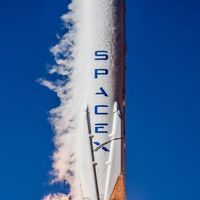The Future of Space: Testing Limits and New Horizons
July 28, 2024, 3:33 pm

Location: United States, Maryland, Greenbelt
Employees: 10001+
Founded date: 1958
Total raised: $25.7B

Location: United States, District of Columbia, Washington
Employees: 5001-10000
Founded date: 2002
Total raised: $7.53B
In the vast expanse of space, innovation often dances with destruction. Recently, NASA and Sierra Space conducted a dramatic test of their LIFE (Large Integrated Flexible Environment) space station. This was not just a routine check; it was a spectacle of science. The inflatable station was intentionally blown up. Yes, you read that right. This was the second time this year that the LIFE station met its fiery end.
Why would they do this? To push boundaries. To understand limits. The LIFE station is a potential successor to the International Space Station (ISS). It needs to withstand the harsh realities of space. So, they inflated it to 74 psi, well beyond the recommended 60.8 psi. The result? A spectacular explosion that provided valuable data.
This test was a bold statement. It showed that NASA and Sierra Space are not afraid to take risks. They are building the future of space exploration. The LIFE station is designed to be flexible and resilient. It aims to support human life in orbit. The explosion was a necessary step in ensuring its safety and functionality.
The ISS has served humanity for over two decades. But like all good things, it must come to an end. NASA plans to decommission the ISS in the next decade. This opens the door for new players in the space arena. Companies like Airbus, Voyager Space, and Blue Origin are stepping up. Each has its vision for the next generation of space stations.
Airbus has introduced the LOOP concept, a futuristic design that promises to revolutionize life in space. Voyager Space and Airbus are collaborating on Starlab, a station that could replace the ISS. Blue Origin's Reef Space Station is also in the mix, backed by NASA's support.
The competition is fierce. Each company is vying for a piece of the cosmic pie. They are not just building stations; they are crafting the future of human presence in space. The stakes are high, and the rewards could be monumental.
Meanwhile, SpaceX is making headlines with its upcoming Crew-9 mission. Scheduled for launch no earlier than August 18, this mission will ferry astronauts to the ISS. SpaceX has become a household name in space travel. Its reusable rockets have changed the game. They have made space more accessible and affordable.
NASA's partnership with SpaceX is a cornerstone of its commercial crew program. This collaboration has transformed how astronauts reach the ISS. It has also opened the door for private companies to participate in space exploration.
As we look to the stars, the landscape of space travel is evolving. The LIFE station's explosive tests are just one piece of the puzzle. They highlight the importance of rigorous testing in developing new technologies. Each explosion, each launch, brings us closer to understanding the cosmos.
The future of space is not just about exploration; it's about sustainability. As we venture further into the universe, we must consider the impact of our actions. The new space stations must be designed with sustainability in mind. They should support long-term human habitation without compromising the environment.
The LIFE station aims to be a model for this new era. Its inflatable design allows for easy transport and deployment. This flexibility could be crucial for future missions to Mars and beyond.
In the coming years, we will witness a transformation in how we approach space. The ISS has been a remarkable achievement, but it is time to look forward. The next generation of space stations will be more advanced, more efficient, and more capable of supporting human life.
As NASA and its partners continue to innovate, the possibilities are endless. The tests, the launches, the collaborations—they are all stepping stones to a brighter future in space.
In conclusion, the recent explosion of the LIFE space station is a testament to the boldness of modern space exploration. It is a reminder that progress often comes with risks. As we stand on the brink of a new era, we must embrace the challenges ahead. The universe is vast, and our journey has just begun.
With each test and each mission, we are not just reaching for the stars; we are paving the way for future generations. The future of space is bright, and it is ours to explore.
Why would they do this? To push boundaries. To understand limits. The LIFE station is a potential successor to the International Space Station (ISS). It needs to withstand the harsh realities of space. So, they inflated it to 74 psi, well beyond the recommended 60.8 psi. The result? A spectacular explosion that provided valuable data.
This test was a bold statement. It showed that NASA and Sierra Space are not afraid to take risks. They are building the future of space exploration. The LIFE station is designed to be flexible and resilient. It aims to support human life in orbit. The explosion was a necessary step in ensuring its safety and functionality.
The ISS has served humanity for over two decades. But like all good things, it must come to an end. NASA plans to decommission the ISS in the next decade. This opens the door for new players in the space arena. Companies like Airbus, Voyager Space, and Blue Origin are stepping up. Each has its vision for the next generation of space stations.
Airbus has introduced the LOOP concept, a futuristic design that promises to revolutionize life in space. Voyager Space and Airbus are collaborating on Starlab, a station that could replace the ISS. Blue Origin's Reef Space Station is also in the mix, backed by NASA's support.
The competition is fierce. Each company is vying for a piece of the cosmic pie. They are not just building stations; they are crafting the future of human presence in space. The stakes are high, and the rewards could be monumental.
Meanwhile, SpaceX is making headlines with its upcoming Crew-9 mission. Scheduled for launch no earlier than August 18, this mission will ferry astronauts to the ISS. SpaceX has become a household name in space travel. Its reusable rockets have changed the game. They have made space more accessible and affordable.
NASA's partnership with SpaceX is a cornerstone of its commercial crew program. This collaboration has transformed how astronauts reach the ISS. It has also opened the door for private companies to participate in space exploration.
As we look to the stars, the landscape of space travel is evolving. The LIFE station's explosive tests are just one piece of the puzzle. They highlight the importance of rigorous testing in developing new technologies. Each explosion, each launch, brings us closer to understanding the cosmos.
The future of space is not just about exploration; it's about sustainability. As we venture further into the universe, we must consider the impact of our actions. The new space stations must be designed with sustainability in mind. They should support long-term human habitation without compromising the environment.
The LIFE station aims to be a model for this new era. Its inflatable design allows for easy transport and deployment. This flexibility could be crucial for future missions to Mars and beyond.
In the coming years, we will witness a transformation in how we approach space. The ISS has been a remarkable achievement, but it is time to look forward. The next generation of space stations will be more advanced, more efficient, and more capable of supporting human life.
As NASA and its partners continue to innovate, the possibilities are endless. The tests, the launches, the collaborations—they are all stepping stones to a brighter future in space.
In conclusion, the recent explosion of the LIFE space station is a testament to the boldness of modern space exploration. It is a reminder that progress often comes with risks. As we stand on the brink of a new era, we must embrace the challenges ahead. The universe is vast, and our journey has just begun.
With each test and each mission, we are not just reaching for the stars; we are paving the way for future generations. The future of space is bright, and it is ours to explore.